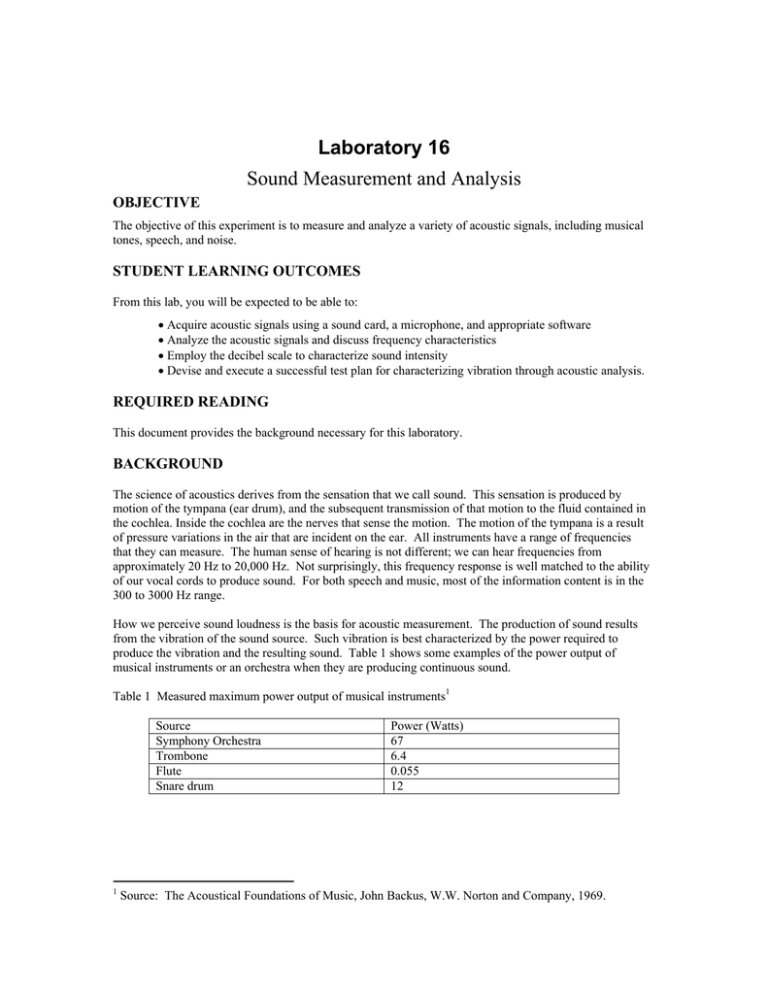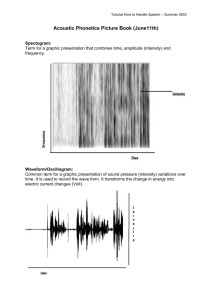Laboratory 16 OBJECTIVE
advertisement

Laboratory 16 Sound Measurement and Analysis OBJECTIVE The objective of this experiment is to measure and analyze a variety of acoustic signals, including musical tones, speech, and noise. STUDENT LEARNING OUTCOMES From this lab, you will be expected to be able to: • Acquire acoustic signals using a sound card, a microphone, and appropriate software • Analyze the acoustic signals and discuss frequency characteristics • Employ the decibel scale to characterize sound intensity • Devise and execute a successful test plan for characterizing vibration through acoustic analysis. REQUIRED READING This document provides the background necessary for this laboratory. BACKGROUND The science of acoustics derives from the sensation that we call sound. This sensation is produced by motion of the tympana (ear drum), and the subsequent transmission of that motion to the fluid contained in the cochlea. Inside the cochlea are the nerves that sense the motion. The motion of the tympana is a result of pressure variations in the air that are incident on the ear. All instruments have a range of frequencies that they can measure. The human sense of hearing is not different; we can hear frequencies from approximately 20 Hz to 20,000 Hz. Not surprisingly, this frequency response is well matched to the ability of our vocal cords to produce sound. For both speech and music, most of the information content is in the 300 to 3000 Hz range. How we perceive sound loudness is the basis for acoustic measurement. The production of sound results from the vibration of the sound source. Such vibration is best characterized by the power required to produce the vibration and the resulting sound. Table 1 shows some examples of the power output of musical instruments or an orchestra when they are producing continuous sound. Table 1 Measured maximum power output of musical instruments1 Source Symphony Orchestra Trombone Flute Snare drum 1 Power (Watts) 67 6.4 0.055 12 Source: The Acoustical Foundations of Music, John Backus, W.W. Norton and Company, 1969. Sound intensity changes with distance from the source. Consider a point source of sound, as shown in Figure 1 that is generating a total power P. Since our perception of sound is related to the power in the pressure waves the sound intensity at any radial location, R may be expressed I= P 4π R 2 (1) Figure 1 Point sound source and spherical pressure waves So, if we consider a trombone playing at maximum power, and we are, say, 3 m away, the sound intensity would be I= 6.4 4π ( 3) 2 = 0.057 W/m 2 This power represents a very loud sound! The ear is a very sensitive instrument for detecting sound. While there are frequency dependencies in the response of the ear, we can illustrate how sensitive the ear by considering a single frequency, say 1000 Hz, and a source located 3 m away, as for the trombone above. If we listened to that sound at a sound intensity of 0.057 W/m2 we would judge it to be uncomfortably loud. Suppose we move away from the trombone, to a distance of 30 m. The sound intensity drops to 5.7 × 10-4 W/m2 , and we would still describe it as quite loud. What sound intensity level would we describe as very soft? It would correspond to a sound intensity of 10-8 W/m2. In the absence of other sounds, the human ear can detect sound intensities of 10-12 W/m2 . This intensity is designated Io and termed the threshold intensity. Our perception of sound is not linear. In other words a sound that has twice the power does not sound twice as loud. Twice as loud to our perception requires close to 100 time the power. This leads us to base the measure of sound loudness on a logarithmic scale, and express the result in units termed decibels. Thus we define the intensity level as L = 10 log I Io The threshold of pain corresponds to an intensity of 120 dB, and clearly the threshold of hearing is at 0 dB. Also, in a practical sense it is much easier to measure pressure amplitude of sound, and using the fact that the sound intensity is proportional to the square of the sound pressure level, we express the sound pressure level, SPL as L p = 20 log P Po where Po is the sound pressure amplitude corresponding to threshold intensity, and is taken to be 20 µPa. The most common acoustic transducer is the microphone, a device that produces an electrical signal that represents the acoustic pressure at the sensor location. The microphone we use in this exercise is intended for the recording of music and speech, and for that reason it is directional. This means that it is most sensitive to sounds coming from a source in front of the microphone. In all microphones, a membrane or foil moves in response to pressure changes in the air, and a sensor of various designs changes the motion into a voltage signal. ASSIGNMENT The primary task of this laboratory is to acquire and analyze a variety of acoustic signals. The equipment we will employ are an acoustic enclosure, a microphone, a preamplifier, and a CD-quality sound card installed in a PC. Locate each item of equipment, and ensure that you understand the basic operation as described by the instructor. FOR EACH TASK BELOW, THERE ARE RESPONSES REQUIRED ON THE LABORATORY WORKSHEET. 1. The software that we will use provides for recording, replaying, and analyzing in real time sounds. Prior to starting the software, the power to the preamplifier should be off. You should start the software from the desktop. The first exercise is to generate and superimpose two pure tones, a 500 Hz tone and a 501 Hz tone. a. From the main software pull-down menu, choose Generate and then Tones. The default settings should be Sample Rate Channels Resolution 44,100 Hz Mono 16-bit Select OK, and a new dialogue box appears. Set the base frequency to 500 Hz,. The portion of the dialogue box labeled “Frequency components” allows harmonics to be included. Set all of the components to zero except the fundamental (× 1). By clicking OK 10 seconds of a pure 500 Hz tone will be generated. Now in the lower left of the main window there are controls for playing the tone. Click play. Click File New to create a new file. Repeat the procedure described above to generate a 501 Hz tone. From the main window, select edit and copy. Use the window menu to return to the original 500 Hz tone. From the edit menu select mix paste to superimpose the two tones. Superimpose the two and play the result. Select the frequency analysis window and play the signal observing the time dependent frequency content. b. 2. Generate two tones as above, but include the 4th harmonic at a volume level of 60%. Examine the frequency content of speech. In order to record sound using the microphone, the preamplifier should be turned on, and through testing you should determine an appropriate gain setting to provide good recordings. To acquire a signal, choose File and then New. Use the record button on in the controls on the lower left of the window to initiate recording, and the stop button to end the recording. The mouse may be used to select portions of the signal for playback and analysis. Record each lab partner reading the following: "Always do right. This will gratify some people, and astonish the rest." - Mark Twain 3. 4. 5. Place a tuning fork in the acoustic enclosure. “Sound” the tuning fork, and record and analyze the resulting sound. Place the wind chimes in the enclosure, record and analyze the sounds. Sound and record each wind chime individually, then in pairs, and then all together. Sounding the wind chimes individually may be best achieved by holding all but the wind chime being analyzed. Place the cymbal in the enclosure, and record and analyze the sound that results from striking the cymbal in various locations on its surface.






